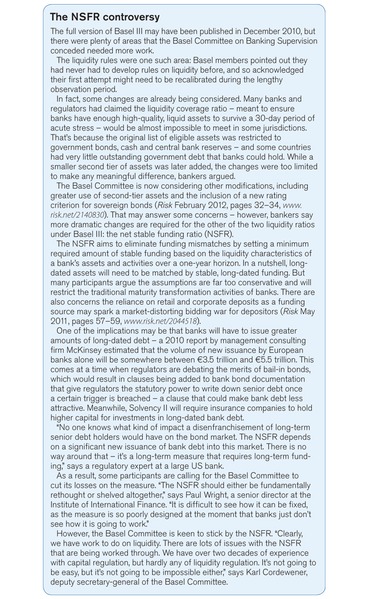
Different preferences create divided implementation of Basel III
The process has been complicated by a Dodd-Frank Act ban on the use of credit ratings within US regulations – essentially forcing a delay to the Basel 2.5 trading book reforms, which officially came into force elsewhere on December 31, 2011. US regulators concocted a work-around at the end of last year, but this has run into criticism from domestic banks, which claim the proposal would put them at a competitive disadvantage (Risk February 2012, pages 19–21).
The Basel Committee isn’t just looking to monitor timelines and compliance with globally agreed minimums, however – it also wants to review consistency in the measurement of RWAs between banks. The SIG has begun an investigation into the issue, a move that has been met with hearty approval from some quarters.
“It’s about time that RWA calculations were looked at by regulators. If left untouched, the problem has the potential to undermine the whole process of capital regulation,” says David Benson, vice-chairman, risk and regulatory affairs, at Nomura in London.
Under Basel II, the most sophisticated banks are allowed to model their own RWA numbers based on an assessment of operational, credit and market risks. This latitude is seen by some market participants as the driving force behind a wide disparity in RWA numbers between banks (Risk July 2011, pages 36–39). For example, according to the Barclays 2011 annual report, its RWA-to-total-assets ratio stood at 25% on December 31, compared to 68% for JP Morgan Chase.
This kind of disparity has led to much huffing and puffing from market participants on both sides of the Atlantic, and has spurred regulators into action. The Basel Committee’s Byres says the current review could end up restricting the flexibility in RWA modelling that banks currently enjoy.
However, doing this will involve a delicate balancing act for the committee. While some market participants agree that changes are needed, there is still a lot of support for banks conducting the calculations in-house. In fact, some argue that variations in RWAs are a natural consequence of different views on risk – and, if everyone had the same opinion on default probabilities, it would lead to herd behaviour among banks.
“It is absolutely vital for RWA calculations to be as transparent as possible, and for there to be proper oversight of the process so investors can make informed decisions,” says Peter Sime, head of risk and research at the International Swaps and Derivatives Association in London. “But it is important for banks to be able to make their own risk judgements. I think everyone is agreed that the more sophisticated a firm is, the more latitude it should be given to calculate its own risk. They’ve got the sophistication and the computing power, so they are the best people to determine what the risk of their portfolios is. If you apply a simple set of rules to a complex portfolio, you get an over-conservative capital calculation. You also increase the likelihood of herd behaviour by banks, where everybody views every asset in exactly the same way, which is detrimental to the market.”
This point has been recognised by the Basel Committee, which is in for the long haul on the RWA review. “We hope to have the initial review completed by the end of the year, but it is likely to be an ongoing process. If we identify areas of material inconsistency, we have to think whether changes to policies or supervisory processes are necessary to narrow that inconsistency. And, over time, we’ll have to re-review to see whether the changes have been implemented and are effective, and whether any new areas of material inconsistency have emerged,” says Byres.

Only users who have a paid subscription or are part of a corporate subscription are able to print or copy content.
To access these options, along with all other subscription benefits, please contact info@risk.net or view our subscription options here: http://subscriptions.risk.net/subscribe
You are currently unable to print this content. Please contact info@risk.net to find out more.
You are currently unable to copy this content. Please contact info@risk.net to find out more.
Copyright Infopro Digital Limited. All rights reserved.
You may share this content using our article tools. Printing this content is for the sole use of the Authorised User (named subscriber), as outlined in our terms and conditions - https://www.infopro-insight.com/terms-conditions/insight-subscriptions/
If you would like to purchase additional rights please email info@risk.net
Copyright Infopro Digital Limited. All rights reserved.
You may share this content using our article tools. Copying this content is for the sole use of the Authorised User (named subscriber), as outlined in our terms and conditions - https://www.infopro-insight.com/terms-conditions/insight-subscriptions/
If you would like to purchase additional rights please email info@risk.net
More on Basel Committee
FRTB implementation: key insights and learnings
Duncan Cryle and Jeff Aziz of SS&C Algorithmics discuss strategic questions and key decisions facing banks as they approach FRTB implementation
Basel concession strengthens US opposition to NSFR
Lobbyists say change to gross derivatives liabilities measure shows the whole ratio is flawed
Basel’s Tsuiki: review of bank rules no free-for-all
Evaluation of new framework by Basel Committee will not be excuse for tweaking pre-agreed rules
Pulling it all together: Challenges and opportunities for banks preparing for FRTB regulation
Content provided by IBM
EU lawmakers consider extending FRTB deadline
European Commission policy expert says current deadline is too ambitious
Custodians could face higher Basel G-Sib surcharges
Data shows removal of cap on substitutability in revised methodology would hit four banks
MEP: Basel too slow to deal with clearing capital clash
Isda AGM: Swinburne criticises Basel’s lethargy on clash between leverage and clearing rules
Fears of fragmentation over Basel shadow banking rules
Step-in risk guidelines could be taken more seriously in the EU than in the US
Most read
- Top 10 operational risks for 2024
- The American way: a stress-test substitute for Basel’s IRRBB?
- Filling gaps in market data with optimal transport







